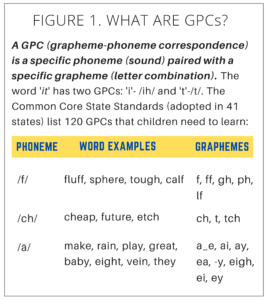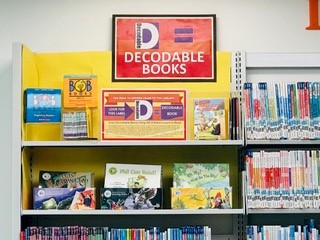“Do you carry any of those special books that help kids that aren’t learning to read easily?” I asked this question to our librarian many years ago. It was early in our journey, and I was still getting my arms around why the reading instruction and interventions at school weren’t working. Fortunately, I knew enough to sign our daughter up for reading services at the one center in our region that uses a structured literacy approach to reading interventions.
The reading tutor told me about these “special books” that children could use to practice their newly learned phonics skills. I’m from educational publishing, so I was curious about what these magical books were. How come I had never heard about them? If they were so unique, I was sure I could write some and maybe help our daughter get over that hump that I define as decoding. Once I learned more I was perplexed about why there were so few decodable books, and why the decodable books I learned about were hard to find.
Fast forward several years, and I’m the Founder of a nonprofit organization, Teach My Kid to Read, initiating our first program, The Road to Decode, that aims to educate librarians about how we learn to read and where resources like decodable books fit in the process. Awareness, education and access to decodable books becomes the core of our program, and we take a deep-dive to help librarians educate the community about decodables and the breadth of the offerings.
For this post, I proudly interview Dr. Neena Saha. Dr. Saha’s innovative work will enable teachers, parents, and anyone helping children learn to read, better align decodable books with a child’s phonics skill.
What is the best way for decodable books to help with early reading skills?
Decodable books should supplement phonics instruction to allow children to practice what they have learned in a controlled environment. For example, if a child has just been taught the m_/m/ letter-sound (or grapheme-phoneme correspondence) in their reading lesson, it is really beneficial to allow them to practice it in a book that has a high occurrence of m_/m/ GPCs. This is good for two reasons. First, it helps cement that particular grapheme-phoneme correspondence (GPC) in their memory (see figure 1-1).

It is one thing to be told that the letter m sounds like /m/ by a teacher, and another to apply it on your own. It is the same concept as when you learn a new language. You can try and learn Spanish on the Duolingo app all day, but eventually, if you want to become fluent, you will have to apply what you have learned in an actual conversation in Spanish. However, imagine for a moment that you learned a word on the app. Then, you were thrown into a real-life conversation that had none of those words you learned. Would you be frustrated? I’m guessing the answer is yes. You were not provided with a controlled environment to practice what you just learned. Decodable books are a controlled environment to practice new phonics skills.
Ideally, decodable books are supposed to match reading lessons in scope and sequence so that children are provided opportunities to practice what they have learned in a way that does not frustrate them. This latter point is important but often overlooked. Let’s return to our Spanish analogy for a second. Imagine if every time you completed a lesson, you were put in a conversation that did not have any of the words you just learned. Not only would this be frustrating, but after a while, you might even lose confidence and want to give up. You might say that Spanish is too difficult and move on to a different hobby. The same is true for children. When reading material is too hard, they can feel frustrated, lose confidence, and want to give up. This is especially the case for struggling readers. Therefore, the importance of decodable text for children’s confidence cannot be understated. It is essential that all children feel like they have the skills necessary to crack the alphabetic code.
How can decodable books help older children struggling to read?
The same way they help emerging or beginning readers who are young: they allow opportunities for practice in a controlled environment. However, other considerations need to be taken into account for older, struggling readers. For example, you want to make sure the book is high-interest, and the student is motivated to read it. Appearances matter, too. Most older kids know that they are supposed to have learned to read already and were resistant to the “little children” books. I’m seeing more and more series of decodable books geared toward older children, but it is an area where I still see a great need.
In general, how do teachers and parents choose decodable books?
There are not any really good methods to choose decodable books right now. Qualitative text measures like Fountas & Pinnell are inaccurate, unreliable, and not research-based. Readability formulas (like Lexiles) only consider a few (usually 2) variables, none of which have to do with decoding. You can read a lot more about the flaws of existing systems in the introduction to our paper.
While some reading programs include sets of decodable books that align nicely with a given scope and sequence, teachers are generally out of luck if they need additional books. That is because there is no easy or widely available tool for matching a book’s GPCs to a phonics scope and sequence.
I think the issue is even harder for parents. First, they have to obtain the scope and sequence from their child’s classroom teacher, and then they have to locate sets of books (or purchase them). This isn’t easy because many libraries are not aware of decodable books’ importance and, thus, do not stock them. I know that Teach My Kid to Read is doing really important work in this area.
If parents wish to purchase decodable books online, it can be hard to figure out the scope and sequence of letter-sounds presented in the books because several do not list them. Even if they are listed, they do not list the percentages. Knowing that s_/s/ is introduced in a book is less helpful than knowing s_/s/ makes up 50% of the sounds in a book. That is an area that we at Elemeno are working to develop better solutions.
Would better evaluations of decodable books improve literacy outcomes? If yes, then how?
Yes, absolutely! We at Elemeno are working on this right now!
Better ways of matching students to texts can increase the efficiency of structured literacy practices. For example, if a child has mastered the m_/m/ GPC, they do not need to practice books with high numbers of the m_/m/ GPC. Part of our current research is to determine books with just the right mix of GPCs for a given child, based on the letter-sounds they already know and which ones they still need to master. This is important because providing a child, an inappropriately matched book can lead to poor student outcomes such as frustration, off-task behavior, or giving up.This is particularly concerning for struggling readers and children with dyslexia. They are often matched with text that is too difficult,and they are poor at picking out appropriate materials for themselves.
Tell us about your work with decodable books and algorithms? What is the goal of your research?
We developed a patent-pending algorithm that quantifies the decoding difficulty of text. We are calling it the Decoding System Measure (DSyM). The DSyM assigns a number to a word, a sentence, or an entire book representing how hard it is to decode. Unlike qualitative leveling systems (like Fountas & Pinnell), it focuses specifically on the aspects of words that make them hard to decode, such as (1) blends, (2) which sound a specific letter is making, and (3) the discrepancy between the number of letters in the word and the number of sounds in the word. Unlike readability formulas (like Lexiles), it includes measures of several sub-lexical features of words that studies have shown influence word reading accuracy and reaction time in children. This makes it more appropriate than Lexiles and Fountas & Pinnell for choosing decoding texts.
This work began nearly five years ago at the Education and Brain Research Lab at Vanderbilt University. Our decoding measure has been presented at several international reading conferences and has led to several peer-reviewed publications. Furthermore, our initial validation evidence has shown that the DSyM predicts children’s word-reading errors better than existing text measures such as Lexiles, and, critically, does so better for children with poor reading skills, including those with dyslexic profiles. You can read the full paper here.
We are currently working on ways to help teachers and parents find decodable books. One way we are doing this is to develop an app that matches children to books based on individual GPCs. This work is still in development, but we have assembled a strong team of reading experts that are passionate about providing a research-based solution to parents and teachers, and we are really excited about the possibilities!
What advice do you have for parents and teachers choosing decodable texts to help children learn to read?
First, I would say good for you! You’ve taken an important step in recognizing that decodable books are necessary. While it might be challenging to find books right now, I think the current trends in reading research and practice will place a greater emphasis on the use of decodable books, and I think the market will respond with more publishers creating books. Our technology will help teachers and parents find the exact book for their child at the right time. My advice for now: stay tuned! I think this is an exciting area of research.
Additional comments
If you would like to be a beta tester of our app please sign up on the contact form on Elemeno’s website and indicate in the message space you would like to be a tester!
Join the Teach My Kid to Read Facebook Group, “Let’s Talk Decodable Books and Literacy Resources,” and learn from other educators, parents, caregivers, librarians and publishers more about decodable books.
About Dr. Neena Saha
Inspired by her previous career as a teacher, Dr. Neena Saha founded Elemeno™ to help bridge the research-to-practice gap in early literacy. Neena taught reading to children with exceptional needs for several years before returning to school for graduate training in educational neuroscience from Columbia University. She received her doctorate in special education from Vanderbilt’s Peabody College, where her focus of research was on individual differences in decoding skill acquisition. Her research can be found in The Journal of Learning Disabilities, Annals of Dyslexia, and Reading and Writing: An Interdisciplinary Journal.
